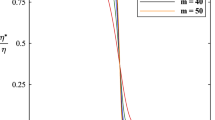Abstract
The flow of 3 to 100 wppm aqueous solutions of a polyethyleneoxide polymer,M w=6.2×;106, was studied in a 10.2 mm i.d. pipe lined with 0.15 mm V-groove riblets, at diametral Reynolds numbers from 300 to 150000. Measurements in the riblet pipe were accompanied by simultaneous measurements in a smooth pipe of the same diameter placed in tandem. The chosen conditions provided turbulent drag reductions from zero to the asymptotic maximum possible. The onset of polymer-induced drag reduction in the riblet pipe occurred at the same wall shear stress, τ* w =0.65 N/m2, as that in the smooth pipe. After onset, the polymer solutions in the riblet pipe initially exhibited linear segments on Prandtl-Karman coordinates, akin to those seen in the smooth pipe, with specific slope increment\(\delta /\sqrt c = 6\). The maximum drag reduction observed in the riblet pipe was independent of polymer concentration and well below the asymptotic maximum drag reduction observed in the smooth pipe. Polymer solution flows in the riblet pipe exhibited three regimes: (i) Hydraulically smooth, in which riblets induced no drag reduction, amid varying, and considerable, polymer-induced drag reduction; this regime extended to non-dimensional riblet heightsh +<5 in solvent andh +<10 in polymer solutions. (ii) Riblet drag reduction, in which riblet-induced flow enhancementR′>0; this regime extended from 5<h +<22 in solvent and from 10<h +<30 in the 3 wppm polymer solution, with respective maximaR′=0.6 ath +=14 andR′=1.6 ath +=21. Riblet drag reduction decreased with increasing polymer concentration and increasing polymer-induced flow enhancement S′. (iii) Riblet drag enhancement, whereinR′<0; this regime extended for 22<h +<110 in solvent, withR′→;−2 forh +>70, and was observed in all polymer solutions at highh +, the more so as polymer-induced drag reduction increased, withR′<0 for allS′>8. The greatest drag enhancement in polymer solutions,R′=−7±1 ath +=55 whereS′=20, considerably exceeded that in solvent. Three-dimensional representations of riblet- and polymer-induced drag reductions versus turbulent flow parameters revealed a hitherto unknown “dome” region, 8<h +<31, 0<S′<10, 0<R′<1.5, containing a broad maximum at (h +,S′,R′) = (18, 5, 1.5). The existence of a dome was physically interpreted to suggest that riblets and polymers reduce drag by separate mechanisms.
Similar content being viewed by others
References
Anderson, G.W., Rohr, J.J. and Stanley, S.D., The combined effects of riblets and polymers in pipe flow.J. Fluids Eng. 115 (1993) 213–221.
Bechert, D.W., Bartenwerfer, M., Hoppe, G. and Reif, W.-E., Drag reduction mechanism derived from shark skin. ICAS Paper (1986) 86–183.
Choi, H., Moin, P. and Kim, J., Direct numerical simulation of turbulent flow over riblets.J. Fluid Mech. 255 (1993) 503–539.
Choi, K.-S., Drag reduction mechanisms and near-wall turbulence structure with riblets. In: Gyr, A. (ed.),Structure of Turbulence and Drag Reduction. Berlin: Springer-Verlag (1989) pp. 553–560.
Christodoulou, C., Liu, K.N. and Joseph, D.D., Combined effects of riblets and polymers on drag reduction in pipes.Phys. Fluids. A3(5) (1991) 995–996.
Gaudet, L., Properties of riblets at supersonic speed.Appl. Sci. Res. 46 (1989) 245–254.
Kline, S.J., Reynolds, W.C., Schraub, F.A. and Runstadler, P.W., The structure of turbulent boundary layers.J. Fluid Mech. 30 (1967) 741.
Liu, K., Christodoulou, C., Riccius, O. and Joseph, D.D., Drag reduction in pipes lined with riblets. In: Gyr, A. (ed.),Structure of Turbulence and Drag Reduction. Berlin: Springer-Verlag (1989) pp. 545–552.
Nakao, S.-I., Application of V shape riblets to pipe flows.J. Fluids Eng. 113 (1990) 587–590.
Nitschke, P., Experimental investigation of the turbulent flow in smooth and longitudinal grooved tubes. NASA TM No. 77480 (1983).
Pulles, C.J.A., Krishna Prasad, K. and Nieuwstadt, F.T.M., Turbulence measurements over longitudinal micro-grooved surfaces.Appl. Sci. Res. 46 (1989) 197–208.
Rohr, J., Anderson, G.W. and Reidy, L.W., An experimental investigation of the drag reducing effects of riblet in pipes. In: Sellin, R.H.J. and Moses, R.T. (eds),Drag Reduction in Fluid Flows. Chichester: Ellis Horwood (1990) pp. 263–270.
Sawyer, W.G. and Winter, K.J., An investigation of the effect on turbulent skin friction on surfaces with streamwise grooves. In:Turbulent Drag Reduction by Passive Means. London: Royal Aeronautical Society (1987) pp. 330–362.
Schlichting, H.,Boundary-Layer Theory. 7th Edition. McGraw-Hill (1979).
Tani, I., Drag reduction by riblet viewed as roughness problem.Proc. Japan Acad. B64 (1988) 21–24.
Virk, P.S., Drag reduction in rough pipes.J. Fluid Mech. 45(2) (1971) 225–246.
Virk, P.S., Drag reduction fundamentals.AIChE J. 21(4) (1975) 625–656.
Virk, P.S. and Wagger, D.L., Aspects of mechanism in type B drag reduction. In: Gyr, A. (ed.),Structure of Turbulence and Drag Reduction. Berlin: Springer-Verlag (1989) pp. 201–214.
Walsh, M.J., Drag characteristics of V-groove and transverse curvature riblets. In: Hough, G.R. (ed.),Viscous Flow Drag Reduction. New York: AIAA (1979) pp. 168–184.
Walsh, M.J., Turbulent Boundary layer drag reduction using riblets. AIAA Paper 82–0169 (1982).
Walsh, M.J. and Linemann, A.M., Optimization and application of riblets for turbulent drag reduction. AIAA Paper 84–0347 (1984).
Walsh, M.J., Riblets. In: Bushnell, D.M. and Hefner, J.N. (eds),Viscous Drag Reduction in Boundary Layers. Washington, DC: AIAA (1990) pp. 203–262.
Author information
Authors and Affiliations
Rights and permissions
About this article
Cite this article
Koury, E., Virk, P.S. Drag reduction by polymer solutions in a riblet-lined pipe. Appl. Sci. Res. 54, 323–347 (1995). https://doi.org/10.1007/BF00863517
Received:
Accepted:
Issue Date:
DOI: https://doi.org/10.1007/BF00863517




